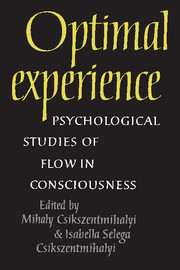Book contents
- Frontmatter
- Contents
- Acknowledgments
- Contributors
- I A THEORETICAL MODEL OF OPTIMAL EXPERIENCE
- II VARIETIES OF THE FLOW EXPERIENCE
- III FLOW AS A WAY OF LIFE
- IV THE MEASUREMENT OF FLOW IN EVERYDAY LIFE
- 15 Introduction to Part IV
- 16 The systematic assessment of flow in daily experience
- 17 The quality of experience in the flow channels: comparison of Italian and U.S. students
- 18 Flow and the quality of experience during work and leisure
- 19 Optimal experience and the uses of talent
- 20 Self-esteem and optimal experience
- 21 Optimal experience and the family context
- 22 The future of flow
- References
- Name index
- Subject index
22 - The future of flow
Published online by Cambridge University Press: 05 June 2012
- Frontmatter
- Contents
- Acknowledgments
- Contributors
- I A THEORETICAL MODEL OF OPTIMAL EXPERIENCE
- II VARIETIES OF THE FLOW EXPERIENCE
- III FLOW AS A WAY OF LIFE
- IV THE MEASUREMENT OF FLOW IN EVERYDAY LIFE
- 15 Introduction to Part IV
- 16 The systematic assessment of flow in daily experience
- 17 The quality of experience in the flow channels: comparison of Italian and U.S. students
- 18 Flow and the quality of experience during work and leisure
- 19 Optimal experience and the uses of talent
- 20 Self-esteem and optimal experience
- 21 Optimal experience and the family context
- 22 The future of flow
- References
- Name index
- Subject index
Summary
At the end of this volume, it is time to assess the cumulative implications of the assembled evidence. What has been learned about flow in the 10 or so years since the model was first presented? The main conclusions, derived from a variety of different studies, seem rather robust. In the first place, it is clear that the flow experience is recognized as a phenomenological reality by people of all ages, both genders, diverse socioeconomic statuses, and very different cultures, and that it is considered a positive state of consciousness by everyone. Thus, we might conclude that flow is a panhuman, species-specific state of positive psychic functioning.
Second, both the flow Questionnaires and the Experience Sampling Method point to the fact that flow is generally an optimal state. In flow, most of the dimensions of experience reach their positive peaks. The relationship between flow and optimal experience is present both in the short and in the long term; those who are in flow most often tend to have more positive experiences in the rest of their lives.
Third, the evidence suggests that there are large individual differences in the quantity and intensity of flow experienced by different persons. Some people appear to have “autotelic personalities” that make it easier for them to enjoy everyday life, and to transform routine and even threatening situations into challenging opportunities for action. A good start has been made to determine what the traits of such persons are, and how patterns of child-rearing might facilitate their development.
- Type
- Chapter
- Information
- Optimal ExperiencePsychological Studies of Flow in Consciousness, pp. 364 - 383Publisher: Cambridge University PressPrint publication year: 1988
- 32
- Cited by



